This article needs additional citations for verification .(December 2009) |
The Chevrolet Townsman was a full-size station wagon produced by Chevrolet from 1953 to 1957 and again from 1969 to 1972.
This article needs additional citations for verification .(December 2009) |
The Chevrolet Townsman was a full-size station wagon produced by Chevrolet from 1953 to 1957 and again from 1969 to 1972.

The Townsman name was first used in 1953 on the 210 series four-door station wagon, and used the GM A platform. For 1954, the name was updated to the luxury Bel Air series station wagon, which featured DI-NOC woodgrain paneling. In both years, all Townsmans were eight-passenger models. In 1955 and 1956, the Townsman was once again a 210, but in 1957 it was available as both a 210 and a Bel Air. All 1955–1957 Townsmans were six-passenger models. A 235.5-cid inline six-cylinder engine was standard power in all five years, with V8s available beginning in 1955.
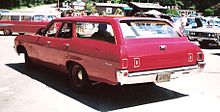
The Townsman name was revived for 1969 with the new model based on the rear-wheel drive GM B platform. It was offered in both six- and nine-passenger versions and only V8s were available, ranging from 327 to 427 cubic inches in 1969, and 350 to 454 cubic inches from 1970 forward. The sedan equivalent in this period was the Bel Air. The Townsman was positioned above the Brookwood and below the Kingswood and Kingswood Estate, which were Biscayne, Impala and Caprice-based wagons respectively.
The 1971 and 1972 wagons featured a 'clamshell' design marketed as the Glide-away tailgate, also called a "disappearing" tailgate because when open, the tailgate was completely out of view. On the clamshell design, the rear power-operated glass slid up into the roof and the lower tailgate (with either manual or optional power operation), lowered completely below the load floor. The manual lower tailgate was counterbalanced by a torque rod similar to the torque rods used in holding a trunk lid open, requiring a 35 lb push to fully lower the gate. Raising the manual gate required a 5 lb pull via a handhold integral to the top edge of the retractable gate. [1] The power operation of both upper glass and lower tailgate became standard equipment in later model years. Wagons with the design featured an optional third row of forward-facing seats accessed by the rear side doors and a folding second-row seat—and could accommodate a 4′ × 8′ sheet of plywood with rear seats folded. The clamshell design required no increased footprint or operational area to open, allowing a user to stand at the cargo opening without impediment of a door—for example, in a closed garage. That year wheelbase also increased from 119 inches to 125 inches, the longest of any Chevrolet regular passenger car ever produced. Most options, aside from power windows and six-way front seat (with driver's control), were available on Townsman (and its less-expensive Brookwood counterpart) wagon models.
Midway through the 1971 model year, Turbo HydraMatic transmission was made standard equipment on all full-sized station wagons, including Townsmans; this eliminated the need for customers to have to specifically specify an automatic transmission that virtually every wagon that had been built since the late 1960s was getting anyway.
For 1973, Chevrolet eliminated the Townsman and upper-level Kingswood/Kingswood Estate designations for its full-sized station wagons. The Bel Air nameplate continued to be applied to all full-sized wagons through 1975 in the United States, and 1981 in Canada. In both countries, the same model-year changes were applied to Bel Air wagons as its more-expensive Impala and Caprice brethren.
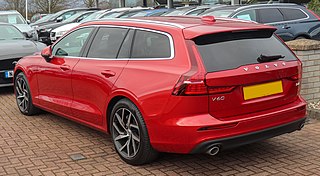
A station wagon or estate car, is an automotive body-style variant of a sedan/saloon with its roof extended rearward over a shared passenger/cargo volume with access at the back via a third or fifth door, instead of a trunk/boot lid. The body style transforms a standard three-box design into a two-box design — to include an A, B, and C-pillar, as well as a D-pillar. Station wagons can flexibly reconfigure their interior volume via fold-down rear seats to prioritize either passenger or cargo volume.

The Chevrolet Impala is a full-sized car built by Chevrolet for model years 1958 to 1985, 1994 to 1996, and 2000 to 2020. The Impala was Chevrolet's popular flagship passenger car and was among the better-selling American-made automobiles in the United States.

The Chevrolet Biscayne was a series of full-size cars produced by the American manufacturer Chevrolet between 1958 and 1975. Named after a show car displayed at the 1955 General Motors Motorama, the Biscayne was the least expensive model in the Chevrolet full-size car range. The absence of most exterior and fancy interior trimmings remained through the life of the series, as the slightly costlier Chevrolet Bel Air offered more interior and exterior features at a price significantly lower than the top-of-the-line Impala and Caprice.
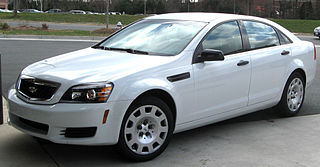
The Chevrolet Caprice is a full-sized automobile produced by Chevrolet in North America for the 1965 to 1996 model years. Full-size Chevrolet sales peaked in 1965 with over a million sold. It was the most popular American car in the sixties and early seventies, which, during its lifetime, included the Biscayne, Bel Air, and Impala.

The Chevrolet Bel Air is a full-size car produced by Chevrolet for the 1950–1975 model years. Initially, only the two-door hardtops in the Chevrolet model range were designated with the Bel Air name from 1950 to 1952. With the 1953 model year, the Bel Air name was changed from a designation for a unique body shape to a premium level of trim applied across a number of body styles. The Bel Air continued with various other trim level designations, and it went from a mid-level trim car to a budget fleet sedan when U.S. production ceased in 1975. Production continued in Canada, for its home market only, through the 1981 model year.

The Pontiac Catalina is a full-size automobile produced by Pontiac from 1950 to 1981. Initially, the name was a trim line on hardtop body styles, first appearing in the 1950 Chieftain Eight and DeLuxe Eight lines. In 1959, it became a separate model as the "entry-level" full-size Pontiac.

The Chevrolet El Camino is a coupé utility vehicle that was produced by Chevrolet between 1959–60 and 1964–1987. Unlike a standard pickup truck, the El Camino was adapted from the standard two-door Chevrolet station wagon platform and integrated the cab and cargo bed into the body.

The B platform is a full-size rear-wheel drive car platform produced by General Motors (GM) from 1926 to 1996. Originally made for Oldsmobile and Buick, all of General Motors's five main makes would use it at some point. It was closely related to the original rear-wheel drive C and D platforms, and was used for convertibles, hardtops, coupes, sedans, and station wagons. With approximately 12,960,000 units built, divided across four marques, the 1965-70 B platform is the fourth best selling automobile platform in history after the Volkswagen Beetle, Ford Model T and the Lada Riva.

Buick Estate is a nameplate that was used by the Buick division of General Motors, denoting its flagship full-size station wagon from 1940 to 1964 and from 1970 to 1996. The Estate nameplate was derived from the term country estate in wealthy suburban areas and estate car, the British term for a station wagon.
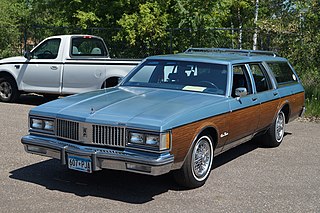
The Oldsmobile Custom Cruiser is an automobile that was manufactured and marketed by Oldsmobile in three generations from 1971 to 1992. The first full-size station wagon produced by Oldsmobile since the 1964 Oldsmobile 88 Fiesta, the Custom Cruiser was slotted above the intermediate Oldsmobile Vista Cruiser in size. The nameplate was first used by Oldsmobile from 1940 to 1947, denoting the top trim level of its C-body model line. 451,819 Custom Cruisers were sold over the years.

The Chevrolet Brookwood is a series of full-size station wagons produced by Chevrolet from 1958 to 1961, and again from 1969 to 1972. It debuted in 1958 as Chevrolet's mid-range model in its station wagon lineup, positioned between the less expensive Yeoman and more luxurious Nomad station wagons. After the Yeoman was discontinued in 1959, the Brookwood was subsequently demoted to entry-level status, before going out of production altogether in 1961. It made a brief reappearance from 1969 and 1972, once again as the least-expensive wagon in Chevrolet's lineup.

The 1957 Chevrolet is a car that was introduced by Chevrolet in September 1956 for the 1957 model year. It was available in three series models: the upscale Bel Air, the mid-range Two-Ten, and the One-Fifty. A two-door station wagon, the Nomad, was produced as a Bel Air model. An upscale trim option called the Delray was available for Two-Ten 2-door sedans. It is a popular and sought after classic car. These vehicles are often restored to their original condition and sometimes modified. The car's image has been frequently used in toys, graphics, music, movies, and television. The '57 Chevy, as it is often known, is an auto icon.

Chevrolet Nomad is a nameplate used by Chevrolet in North America from the 1950s to the 1970s, applied largely to station wagons. Three different Nomads were produced as a distinct model line, with Chevrolet subsequently using the name as a trim package.

The Pontiac Grand Safari was Pontiac's top-of-the-line full-size station wagon offered from 1971 to 1978. The Grand Safari used the grille and interior trim of the Bonneville and Grand Ville passenger car series, and most examples were trimmed with woodgrain paneling on the sides and tailgate.
The Chevrolet Kingswood was a 4-door station wagon produced by Chevrolet in 1959 and 1960, and again from 1969 to 1972 built on the GM B Body platform.
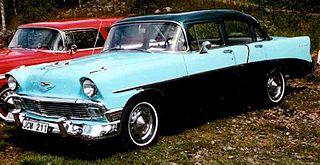
The Chevrolet 210 or Two-Ten is a midrange car from Chevrolet that was marketed from 1953 until 1957. It took its name by shortening the production series number 2100 by one digit in order to capitalize on the 1950s trend toward numerical auto names. The numerical designation "210" was also sporadically used in company literature. It replaced the Styleline DeLuxe model available in previous years. The 210 was discontinued after the 1957 model year to be replaced by the Biscayne.
The Chevrolet Parkwood was a station wagon built by Chevrolet from 1959 to 1961. As the station wagon equivalent of the Bel Air passenger car series, it represented the middle member of the Chevrolet station wagon lineup of those years, above the lowest-priced Brookwood models, but below the luxury-leader Nomad.

The Chevrolet Yeoman was a station wagon produced by Chevrolet for the 1958 model year. The Yeoman was available in two models, a two-door and a four-door, both with six-passenger seating capacity. Based on the Delray passenger car series, the Yeoman represented the entry-level selections in the 1958 Chevrolet station wagon lineup, which also included the Brookwood and the Nomad.

The fifth generation of the Chevrolet Impala is a line of full-size cars produced by Chevrolet from the 1971 to 1976 model years. The largest generation of the model line, the fifth-generation Impala grew to a 121.5-inch wheelbase

The Chevrolet Impala are full-size automobiles produced by Chevrolet for the 1965 through 1970 model years. The 1965 Impala was all new, while the 1967 and 1969 models featured new bodies on the same redesigned perimeter frame introduced on the 1965 models. All Impalas of this generation received annual facelifts as well, distinguishing each model year. Throughout the early 1960s, Chevrolet's basic body designs became increasingly subtle, while the bright trim that was part of the Impala package added more than a touch of luxury to the look. The same pattern was followed in the interiors, where the best materials and equipment Chevrolet had to offer were displayed. In short, the Impala was on its way to becoming a kind of junior-grade Cadillac, which, for both the company and its customers, was just fine.